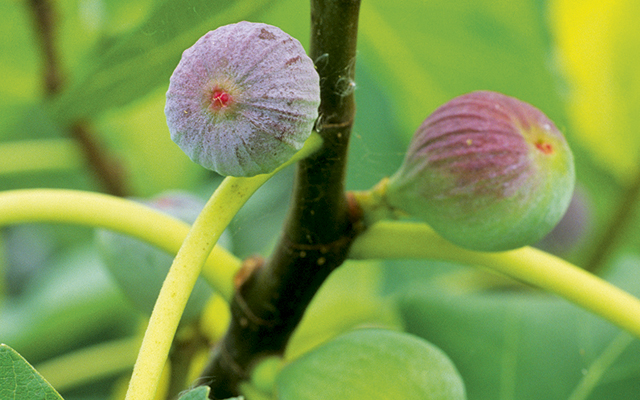How to grow figs
Tom Coward explains the best ways to grow figs, which have been a very successful part of the bumper fruit crop this year

This year really has been an exceptional growing season, resulting in some brilliant fruit crops from the kitchen garden. Our figs are among the star performers, due to the mild winter and hot summer; the trees have been simply dripping with fruit. The first lot ripened by the end of July (the earliest I’ve known) and, throughout August and September, we’ve been gorging on their sweet, sticky flesh. This bumper crop has been such a pleasure that I’ve decided we must increase production, so pro- viding such a feast every year.
Figs are also very handsome trees and worth growing for their beautiful foliage alone. There are some 900 species in the genus Ficus, distributed mainly throughout the Tropics, but Ficus carica, the edible kind grown in gardens, hails from the Middle East, although they’ve been grown in England since Roman times.
Its delicious fruits are actually specially adapted inflorescences called syconia, containing hundreds of flowers within. Although the trees are perfectly hardy, they do need a sheltered, sunny spot to produce good fruit, so, at Gravetye, we have several cultivars fan-trained against a south wall. Brown Turkey is perhaps the best flavoured and most reliable for us, but we also have White Marseilles, which is a little earlier, and Brunswick, which has a deeply indented leaf and is possibly the most beautiful cultivar for foliage.
Figs produce their fruit on the current season’s growth, but, in our short summers, many of them don’t ripen. In warmer climates, a plant will give a succession of crops in one season, starting in the spring with the breba crop. This is derived from fruit that developed the previous autumn, over-wintering as tiny, pea-sized figlets. In England, this is the only usable crop, as we simply don’t have a long enough summer for the following crops to ripen in the same year, so, in the autumn, any figs larger than a pea must be removed so that the tree can concentrate its energy into this single, precious breba crop.
The only way to get more fruit from a fig in England is to extend the season by growing under glass. A fan-trained tree against the wall of a lean-to glass house can give two or even three crops in one season. Growing under glass also allows us to try other delicious varieties that don’t fruit outside.Another possibility is to grow a collection of trees in containers. In the Mediterranean, figs can be seen growing on cliff faces in the tiniest of cracks and, in cultivation, they always crop best if their roots are restricted, making them perfect candidates for pot culture, which has the great advantages of portability and that a greater variety of plants can be grown in a smaller space.
Terracotta pots work best as they drain well and look beautiful. A 2ft-diameter pot can support a healthy fruiting tree, although it’s often visually better to use one a little bigger. Soil-based John Innes No.3 compost is most suitable and it’s particularly important to pot figs quite firmly. As with any pot-grown plant, regular watering and feeding are essential and, every second year, the plants must be taken out of their pots to have the oldest roots pruned away and be re-potted in fresh compost. The plants can be over-wintered in the glass house to protect the baby figlets from winter cold. This barely needs to be heated; just enough to keep it frost free.
Through the spring, the figs will develop earlier under glass, but, after May, it’s possible to move them outside to make space for summer crops such as tomatoes and cucumbers. The trees should make very handsome pot specimens in the garden while the breba ripens, but when autumn sets in, they can come back under glass to try for a second crop of their delicious, sweet fruit.
Sign up for the Country Life Newsletter
Exquisite houses, the beauty of Nature, and how to get the most from your life, straight to your inbox.
Figs are very easy to propagate from hardwood cuttings, which can be taken any time through the autumn. The cuttings are best over-wintered in a cool, frost-free glass house or cold frame, in gritty compost, and, by spring, they should kick into growth.
Among the many nurseries where stock plants can be sourced, Reads in Suffolk (01986 895555; www.readsnursery.co.uk) has a particularly good range.
This article was first published in Country Life magazine on September 10 2014
-
 'To exist in this world relies on the hands of others': Roger Powell and modern British bookbinding
'To exist in this world relies on the hands of others': Roger Powell and modern British bookbindingAn exhibition on the legendary bookbinder Roger Powell reveals not only his great skill, but serves to reconnect us with the joy, power and importance of real craftsmanship.
By Hussein Kesvani
-
 Spam: The tinned meaty treat that brought a taste of the ‘hot-dog life of Hollywood’ to war-weary Britain
Spam: The tinned meaty treat that brought a taste of the ‘hot-dog life of Hollywood’ to war-weary BritainCourtesy of our ‘special relationship’ with the US, Spam was a culinary phenomenon, says Mary Greene. So much so that in 1944, London’s Simpson’s, renowned for its roast beef, was offering creamed Spam casserole instead.
By Country Life